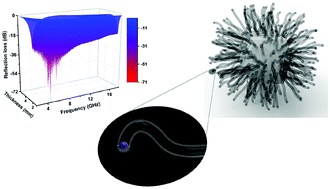Rational design of CNTs with encapsulated Co nanospheres as superior acid- and base-resistant microwave absorbers†
Abstract
Carbon nanotubes with encapsulated Co nanospheres (Co@CNTs) were prepared via a simple approach that exhibits promising control over the morphology and size distribution. The individual CNTs interweave with each other and form a three-dimensional network structure. Test results indicate that the presence of polarized interfaces between the Co spheres and CNTs, as well as an excellent impedance match, leads to a superior performance in electromagnetic wave absorption. A maximum reflection loss of −70.8 dB at 6.24 GHz is obtained for a paraffin containing a 30 wt% Co@CNT inclusion. In addition, the effective absorption bandwidth (with a reflection loss below −10 dB) is 12.95–17.7 GHz at a thickness of 1.9 mm, covering most Ku bands. In particular, such Co@CNT structures demonstrate superior and sustainable electromagnetic wave-absorption properties even in contact with concentrated acid or base, owing to their specific encapsulated structure. These findings could provide new guidelines for the preparation and employment of promising microwave absorption materials that can work under harsh environments through a simple and feasible strategy.



 Please wait while we load your content...
Please wait while we load your content...